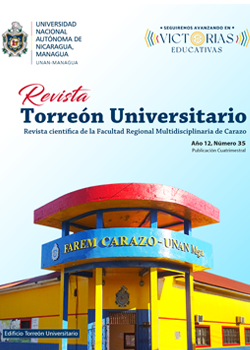UNAN-Managua 2013-2021 curricular plans: analysis within the framework of continuity from degree to postgraduate
DOI:
https://doi.org/10.5377/rtu.v12i35.17006Keywords:
Continuity, Conceptual elements, Extension, Undergraduate and postgraduate training, ResearchAbstract
It is unquestionable that the Higher Education system in Nicaragua and, especially, at UNAN-Managua has been experiencing changes in its curricular management, vision, mission, values and work axes, which generates new and challenging scenarios. One of those is the transformation into a degree and, therefore, this implies improvement in postgraduate careers. For this, it was necessary to carry out a documentary analysis of the curricular designs of the undergraduate courses (2013 and 2021 plans) and identify how continuity occurs in undergraduate and graduate training. The objective was to analyze the main conceptual elements of the curricular plans of the UNAN-Managua courses within the framework of the continuity from undergraduate to postgraduate. The research was carried out using a qualitative approach, a major unit of analysis was identified: the continuity of the degree in the postgraduate degree, and minor ones: conceptual elements of the 2013 and 2021 curricular plans based on the continuity of degree training in the postgraduate degree; curricular improvement and linking degree to postgraduate degree. For data analysis, a double entry matrix was created. Also, information triangulation was applied, considering the objectives, research questions and units of analysis. This article presents a description of essential elements of both plans from a central perspective; elements that unite and disagree, application in daily activities or curricular management and its relationship with postgraduate careers, as well as the coherence between the training and research processes in relation to the continuity of competencies from undergraduate to postgraduate and the development of lines research at both levels.
Downloads
References
Ary, D. (1990). Introducción a la investigación en educación. Nueva York: Holt, Rinehart and Winston, Inc.
Balestrini, P. (2006). Problemas de Investigación . Venzuela.
Baxter, E. (2003). El proceso de investigación en la metodología cualitativa. El enfoque participativo y la investigación en acción. Metodología de la investigación educativa: desafíos y polémicas actuales. Felix Varela.
Best, A. (1972). Investigación educativa: enfoques cuantitativos, cualitativos y mixtos . Argentina: Sage.
Bunge, M. (1998). La Investigación científica. . Buenos Aires: Ariel.
Cazares, M. (2012). Una reflexión teórica del currículum y los diferentes enfoques curriculares. http://www.colombiaaprende.edu.co/html/mediateca/1607/article-170863.html
Escobar, Á. A. (16 de Octubre de 2016). Esquemas de aprendizaje de la gamática. Mangua.
Gaitán, J., & Puñuel, J. (1999). Metodología General. Conocimiento científico e investigación en la comunicación social. Madrid: Síntesis.
Hernández, R., Fernández, C., & Baptista, P. (2010). Metodología de la Investigacion. Mexico: McGrawHill.
Hernández, R., Fernández, C., & Baptista, P. (2010). Metodología de la Investigacion. Mexico: McGrawHill.
Kerlinger, F. (1997). Investigación del comportamiento. Técnicas y Metodología . . México, D.F: Interamericana.
Latorre, A. (2003). Investigacion Accion. . Barcelona: GRAO.
Lawsy, K., & McLeod, R. (05 de Junio de 2010). Case study and grounded theory: Sharing some alternative qualitative research methodology with systems professionals. Artículo presentado a la 22nd International Conference of Systems Dynamics., 29.
Monja, M. (1993). Programa de enseñanza de habilidades de interactivas (4ta ed.). Madrid: CEPE.
Piñuel, R., & Gaitán, C. (1999). Investigación, comunicación y universidad. Salamanca: Comunicación Social.
Restrepo, B. (1997). Investigación en Educación. Programa de Especialización en Teoría, Métodos y Técnicas de Investigación Social. . Bogotá, Colombia: Santafé de Bogotá.
Salatino, D. (2009). Semiótica de los sistemas reales. Análisis semiótico de la emergencia psico-bio-socio-cultural. México.
Serbia. (2007). Diseño, muestreo y análisis en la investigación cualitativa. Hologramática.
Serbia. (2007). Diseño, muestreo y análisis en la investigación cualitativa. . Hologramática.
Solís. (18 de Octubre de 2003). El análisis documental como eslabón para la recuperación de información y los servicios. Obtenido de http://www.monografias.com/ trabajos14/analisisdocum/analisisdocum.shtml
Tusón, A. (1999). Análisi de la conversa. . Barcelona: Ariel.
UNAN,Managua. (02 de Septiembre de 2011). Modelo Educativo,Normativa y Metodología para la Planificación Curricular. Managua, Nicaragua.
UNAN,Managua. . (02 de Septiembre de 2016). Modelo Educativo,Normativa y Metodología para la Planificación Curricular. Managua, Nicaragua.
UNAN-Managua. (2013). Malla curricular de la carrera Contaduría Publica y Finanzas. Managua, Nicaragua.
UNAN-Managua. (06 de Agosto de 2015). Modelo Educativo, Normativa y Metodología para la Planificación Curricular 2011. Managua, Nicaragua.
UNAN-Managua. (23 de Abril de 2021). Diseño Curricular para Desarrollar Competencias en la UNAN-MANAGUA. Managua, Niacargua. Universidad Nacional Autónoma de Nicaragua, Managua. (23 de Abril de 2021). Managua, Nicaragua.
UNAN-Managua. (26 de Noviembre de 2021). Normativa de pràctica de formación profesional (PFP) y pasantías . Managua, Nicaragua: UNAN-Managua.
Published
How to Cite
Issue
Section
License
Copyright (c) 2023 National Autonomous University of Nicaragua, Managua

This work is licensed under a Creative Commons Attribution-NonCommercial-NoDerivatives 4.0 International License.
Los autores que publican en esta revista están de acuerdo con los siguientes términos.
- El autor o los autores de los artículos, ensayos o investigaciones conceden a la Universidad Nacional Autónoma de Nicaragua, Managua (UNAN-Managua) los derechos de edición (copyright) del trabajo enviado, por consiguiente la Universidad cuenta con el derecho exclusivo para publicar el artículo durante el periodo completo de los derechos de autor.
- Estos derechos de autor/ autores autorizan a la Revista Torreón Universitario y a la Universidad editar y divulgar/publicar el artículo en dicha Revista, incluyendo reproducción impresa y electrónica, el almacenamiento, recuperación y cualquier otro tipo de publicación, y fuentes de información secundaria como servicios de resúmenes y bases de datos, así mismo la facultan a proteger el artículo contra el uso no autorizado para su difusión por medios impresos o electrónicos (PDF, HTML, EPUB, XML u otros).
Licencia para el uso del contenido
La revista hace uso de la Licencia Creative Commons Atribución-NoComercial-SinDerivar 4.0 Internacional.
Bajo esta declaración:

Este revista está sujeta a una licencia de Creative Commons Reconocimiento-NoComercial-SinObraDerivada 4.0 Internacional. Puede ser copiada, distribuida y transmitida públicamente siempre y cuando se cite al autor y la fuente (Revista Torreón Universitario), no debe modificarse ni utilizarse con ningún fin comercial. La licencia completa se puede consultar en http://creativecommons.org/licenses/by-nc-nd/4.0/.

